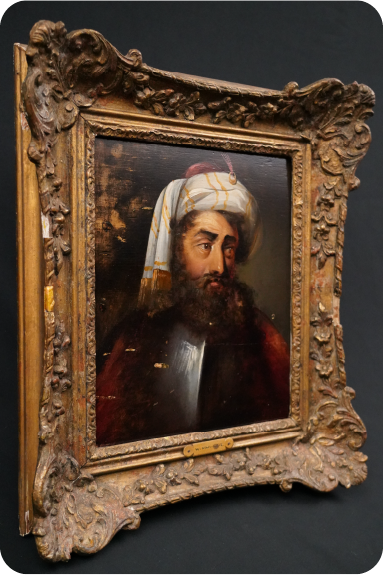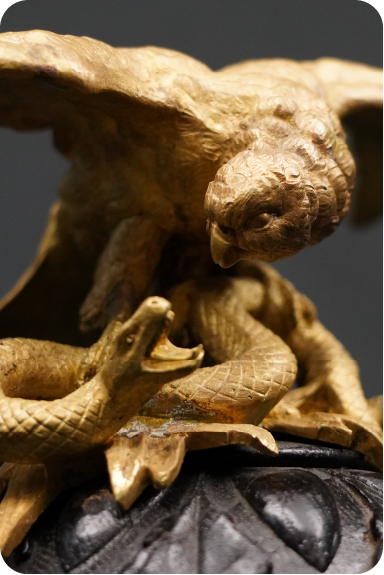Wave 1 of Consignments
1: Salvador Dali: The Divine Comedie, Purgatory Canto 5, Virgil Reproaches, 1960


Hand signed, wood-engraved print, in gilt frame, certificate of authenticity provided.
In 1950 the Italian government commissioned renowned Catalonian artist Salvador Dali to illustrate the Divina Commedia, or Divine Comedie (1307) of Dante Alighieri (1265-1321) for a publication marking the 700th anniversary of Dante’s birth.
Dali produced 101 watercolors between 1950 – 1959, illustrating each of the 100 cantos of Dante’s masterpiece plus a title page. But the Italian public was indignant that a Spaniard was to illustrate the work of their great national poet, and insisted it be done by an Italian.
Dali then presented his 101 watercolors to the French printer Jean Forêt, who agreed to publish the Divina Commedia text in French with Dali's illustrations. To this end, the watercolors needed be made suitable for printing.
It took 50 months (April 1959 - November 1963) to engrave the approximately 3500 woodblocks: on average, 35 blocks were required to render the rich color palette of each of the 101 watercolors.In contrast to woodcuts, in which cuts are made upon the grain of the wood, wood engravings are made in the dense end grain of the wood block. This allows the artist to create thin delicate lines of detail, as well as large colored areas.
Overall Dimensions:Inches: 26 x 22.5 CM: 67 x 57
Subject: Deep in Purgatory, Virgil finds a long dead countryman. The two bemoan the death of Rome and the fragmented state of High Medieval Italy, before the dead man asks:
Sordello backward drew exclaiming, “Who are ye?” “I am Virgil, for no sin Depriv’d of heav’n, except for lack of faith.” So answer’d him in few my gentle guide. And drawing near with reverential step Sordello Caught him. “Glory of Latium!” he exclaim’d, “In whom our tongue its utmost power display’d!
2: Portrait of a Young Man (after Titian): J. Sreve 1883


Oil on canvas, signed and dated J. Sreve, Munchen 1883 at the lower right corner and in pencil on the reverse, in a contemporary gilt frame, certificate of authenticity provided.
The original Titian portrait, which hangs in the Alte Pinakothek Museum, Munich, depicts a man of aristocratic mien. He wears elegant period dress, a pleated white blouse and black cloak. His intelligent face, bearded and attentive and gazing to the viewer’s left, is illuminated against a typically dark background, a central characteristic of Titian’s portraiture.
We are unaware of other paintings by the artist, J. Sreve. Clearly, he or she was truly skilled, accurately capturing the sensitivity of Titian’s strokes and conveying the compelling quality of the sitter’s pondering gaze. Yet discerning viewers will also observe additional Renaissance influences on this artist’s work, including those of Giorgione and Dosso Dossi, both Venetian contemporaries of Titian. These invest our portrait with an ethereal and expanded sense which gently step beyond the original.
What has rightly been observed of Titian himself may be said of Sreve as well: though the sitter’s identity remains a mystery, the artist’s astonishing naturalism has eternalized not only his appearance, but his soul.
Overall dimensions: Inches: 36 x 30.5 CM: 91.5 x 77.5
3: Portrait of an Old Testament Hero: Muller, mid-19th c.


Oil on panel, period gilt and gesso frame, certificate of authenticity provided.
Attributed to William James Muller, English, born in Bristol, of Prussian descent (1812-1845.) In his short life, Muller painted landscapes, street scenes and portraits which became enormously popular following his death at age 35. He visited Greece and the Middle East in the latter 1830s, and the Ottoman Empire in the mid-1840s; it is from this time when our portrait likely dates.
Old Testament narratives, particularly those involving heroes, had been extremely popular among both religious and secular audiences throughout Europe since the Romans adopted Christianity, however during the Italian Renaissance, it became the trend to represent Ancient Hebrews in Ottoman dress of the period.
Hence, the subject of this portrait, likely representing the hero Joshua who conquered Jericho, with large, expressive eyes and flowing beard, indicating compassion and wisdom respectively, wears distinctly Ottoman headgear: a large turban cloth of silk woven with gilt thread and fringe, complete with aigrette, or feathered turban pin, worn over a fez (conical cap.) This is paired anachronistically with a 16th century European armor breastplate with deep central ridge.
Although historically and geographically diverse, these visual cues informed the viewing audience, many of whom would have been illiterate, that the subject was a wise and compassionate, pre-Christian Biblical warrior.
In its original carved wood frame with gesso and gilding and a brass tag inscribed W. MULLER,Showing losses and rubbing. The painting with gouges and scratches, recently cleaned and varnished.
Overall dimensions: Inches: 17 x 16 CM: 43 x 40.5
4: A Gilt Bronze Sculpture C. 1830


Gilded bronze on oak, certificate of authenticity provided.
A classic struggle between two ancient totems, creatures which struck both pride and fear into ancient man and personified the challenges faced by early explorers and the intrepid men who won the West. A hawk and serpent locked in battle, fully modeled in bronze, the hawk with wings extended and claws gripping the serpent in triumph, the serpent coiled, with jaws wide in defiance and fangs bared to strike. Superb modeling and action, with eyes, claws feathers and scales finely delineated. On its fine, foliate-carved oak plinth.
Overall dimensions: Inches: H-9 W-11 D-7.5 CM: H-23 W-28 D-19
5: An Ancient Greek Silver Kylix C. 350 BCE
Handwrought silver, certificate of authenticity provided.
The kylix, or cup, was of great importance throughout the history of ancient Greece. More highly regarded even than plates or tripods, the kylix held special value among men. It served to pour libations to the gods, and was lifted to heroes, past and present, as the highest level of respect:
“When the bard left off singing Ulysses wiped the tears from his eyes, uncovered his face, and, taking his cup, made a drink-offering to the gods.”
-The Odyssey, Book VIII
Examples such as ours, wrought of solid silver, were important votive offerings to the gods, considered the perfect host-gift to kings and champions. The kylix was of course a primary symbol of the god of wine and festivity, Dionysos, as well. Our example is of silver, refined by smiths from ore probably mined at Laurion, south of Athens, cast in enormous ingots and then pounded into sheet before being hand-raised. Its elegant, footed, curvilineal form places it in the latter Hellenistic era, possibly as early as the reign of Alexander the Great (356-323 bce.)
Overall dimensions: Inches: H-3 1/8 W-3 ½ CM: H-8 W-9
6: An Ancient Greek Helmet, C. Third Century BCE


An iconic type devised, by tradition, in ancient Chalcis on the Island of Euboea. Superbly wrought of sheet bronze in characteristic form, the deeply-domed phalliform skull wrought in two sections developing into a rigid nape, with overlapping juncture and embossed with radiating ribs terminating in a horizontal lineal border surmounting a fine and unusual dentated motif around the periphery and terminating in an integral nasal with profiled brow, the lower periphery with a pronounced rim embossed in relief, providing glancing surfaces which protected the eyes and nose The characteristic hinged cheek plates embossed en suite with dentated decoration and raised borders as well.
Such helmets were initially made on the Greek mainland for export to Lydia, as Asia Minor was then known. They met with great popularity among the Scythians and Sarmatians, nomadic horse pastoralists who encountered Greek traders around the Black Sea between the fifth and third century b.c.e. and adopted various forms of Greek arms and armor, the Chalcidian helmet being perhaps the most widespread.
Fourth – Second century BCE. Good excavated condition, conserved, with minor areas of repair and restoration.
Height: Inches: 11.25 CM: 28.5
7: A Rare Ottoman Karabela Saber 17th Century


Among the rarest type of swords, with few if any known outside museums. Most known examples were acquired by Polish cavalry and Austrian infantry during the rout of the Ottoman camp outside Vienna in 1683. Likely made in the Ottoman Court Workshop for a nobleman, the hardwood grips of characteristic hooked form, carved with chevrons and retained by silver-gilt rivets, the guard of silver, chiseled, engraved, gilded and nielloed and struck with the tugra of Sultan Mehmet IV (r. 1648-1687.) Scabbard of wood covered in black leather and mounted en suite with the hilt, with fine engraved, nielloed and gilded silver, the locket and chape also struck with the sultan’s tugra. The superior handwrought wootz blade (crucible damascus steel) of characteristic 17th century form, lightly curved and broad, with pronounced back edge and elaborately inlaid for most of its surface with Quranic benedictions and prayers in high-karat gold, notably the Throne Verse (Quran 2:255: His throne extends over the heavens and the Earth, and He is never weary of preserving them. He is the Most High, the Magnificent.)
Second half of the 17th century. Provenance: Rolkó Collection, Budapest. Showing very minor wear for its considerable age.
Overall length in scabbard: Inches: 38 CM: 96.5
8. A Bronze Sculpture of Ulysses Bending his Bow, after Bousseau 19th Century


Bronze casting, on a solid marble base.
A fine 19th Century bronze sculpture after the original created by famed sculptor Jacques Bousseau (1681-1740) in 1715. Bousseau was a pupil of the celebrated Baroque period sculptor Nicholas Coustou (1658-1733), and went on to be appointed Court Sculptor to King Louis XIV. His fine Neoclassical works remained in high demand throughout the 19th Century, resulting in the production of a limited number of fine bornzes; ours is one of this group.
After 10 years fighting before the walls of Troy under the brother kings Menelaus and Agamemnon, beside heroes like Achilles and Ajax, and eventually devising the Trojan Horse, and another decade wandering the Mediterranean, Odysseus, known by the Romans as Ulysses, at last finds himself home on the Island of Ithaka, where he is king. He appears an old beggar so as not to be recognized by the local nobles, who have despoiled Ithaka in his absence, and intend to force Penelope, his beloved wife, to declare him dead at last and marry one of them. Penelope will be forced to marry that man who can string Ulysses’ bow and shoot an arrow straight through the rings on a series of axes arranged in a row. In the climactic moment of the Odyssey, all the men have failed to even string the famous bow. Ulysses has asked to handle it, as the others smirk and snicker. If they could not manage the great bow, how can this bedraggled stranger? Despite the passage of decades and the many trials, Ulysses bends and strings the bow with practiced ease. The instant is stunningly achieved in bronze, the folds of his chiton, a helm and quiver full of arrows displayed at the base, and even the corded twine of the bow string and the leather fringe hanging from the bow’s grip. Ulysses’ stance, his determined features and force of will, corded muscles and wild hair stunningly, movingly convey the strength and commitment he martials in that instant, to protect his own:
Ulysses had taken up the bow, examined it all over, and strung it as easily as a skilled bard strings a new peg of his lyre. Then he took it in his right hand to prove the string, and it sang sweetly under his touch like the twittering of a swallow. Jove thundered loudly as a sign, and the heart of Ulysses rejoiced. He took an arrow that was lying upon the table, he laid it on the centre-piece of the bow, and drew the notch of the arrow and the string toward him. When he had taken aim he let fly, and his arrow pierced every one of the handle-holes of the axes.
-The Odyssey, Book XXI
Height: Inches 21.75 CM: 55.25




